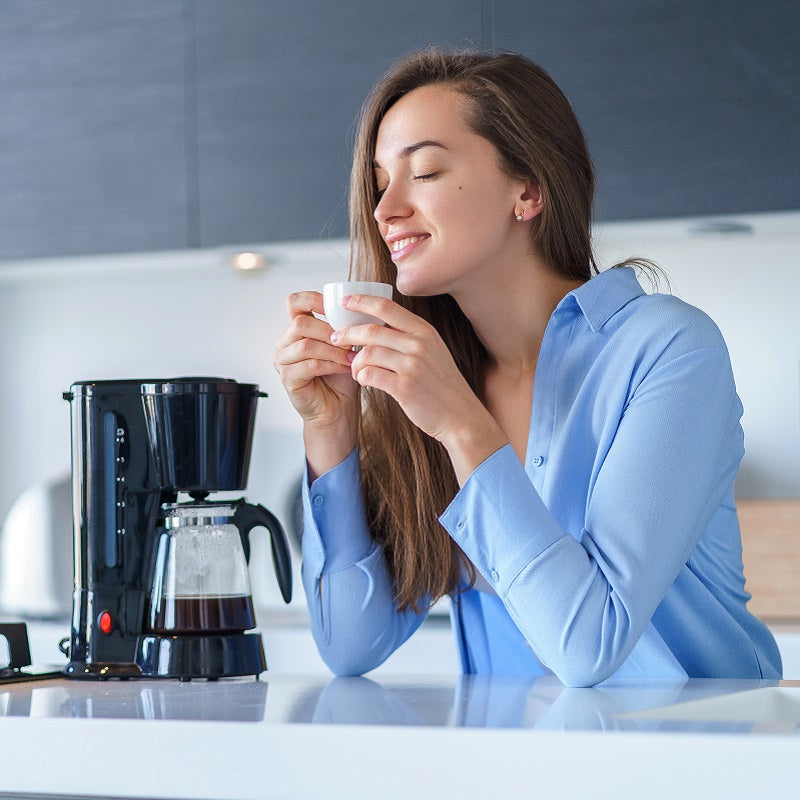Whether you’re a seasoned coffee aficionado or just starting out, mastering how to use a coffee maker is an essential skill for crafting that perfect cup of coffee. In this comprehensive guide, we’ll walk you through seven crucial steps to achieve your ideal brew, from selecting the right beans to mastering the brewing process.
Step 1: Understanding Your Coffee Maker
Before we start brewing, it’s important to understand the type of coffee machine you’re working with. There are several types of specialty coffee makers, each with its unique brewing method:
- Drip Coffee Makers: Understanding how drip coffee makers work is pretty simple. Just add your coffee ground to the filter, pour in water, and let the machine drip the hot water through.
- French Press: This manual method allows for steeping coffee grounds in boiling water, then pressing them down with a plunger.
- Espresso Machines: For those who prefer a stronger brew, espresso machines use high pressure to force hot water through finely-ground coffee.
Selecting the right coffee maker depends on your personal preferences. Do you value convenience or flavor? Do you drink your coffee black or with milk? These questions will help guide your choice.
In addition to the types of coffee makers mentioned, it's worth exploring a few more options that coffee enthusiasts might encounter:
- Single-Serve Pod Machines: These are perfect for those who value convenience and speed. They use pre-packaged pods or capsules containing coffee grounds. While they offer less control over the brewing process, they are ideal for a quick, consistent cup of coffee with minimal cleanup.
- Pour-Over Coffee Makers: This method involves manually pouring hot water over coffee grounds in a filter. The water then drips through the coffee and filter into a carafe or mug. Pour-over brewing gives you control over the speed and distribution of the water, allowing for a more nuanced extraction of flavors.
Each type of coffee maker can impact the flavor and strength of your coffee, so choosing one that aligns with your taste preferences and lifestyle is crucial.

Step 2: Selecting Quality Coffee Beans
The foundation of a great cup of coffee is high-quality coffee beans. Here’s what to consider:
- Bean Types and Roasts: Beans come in various types and roasts, from light to dark. Light roasts are generally more acidic and retain more of the bean’s original flavor, while dark roasts have a fuller body and richer flavor.
- Freshness: Fresh beans are crucial for a good cup of coffee. Look for beans that have been roasted within the past two weeks.
The Role of Bean Freshness
Freshness significantly impacts the flavor of your coffee. Over time, coffee beans lose their oils and degrade. To ensure freshness:
- Storage: Store your beans in an airtight container away from light and heat.
- Purchase in Small Quantities: Buy smaller amounts of coffee more frequently to ensure you’re always using fresh beans.
Step 3: The Art of Grinding Coffee Beans
Grinding your beans is a critical step in the coffee-making process. The grind size affects the surface area exposed to water and, therefore, the extraction rate:
- Grind Size: A coarse grind is ideal for French presses, while a fine grind is best for espresso machines.
- Grinder Type: Burr grinders are preferred over blade grinders for a more consistent grind size.
Grinding coffee is not just about the size; it's also about the freshness of the grind:
- Timing of Grinding: Grinding your beans right before brewing is ideal. Pre-ground coffee can lose its flavor quickly. If you grind your beans at home, you’ll notice a significant difference in the freshness and flavor of your coffee.
- Consistency of Grind: A consistent grind is key to even extraction. Inconsistent grinds can lead to uneven extraction, where some coffee particles are over-extracted, and others are under-extracted, resulting in a less balanced cup.
Investing in a good quality grinder and grinding your beans fresh for each brew can significantly elevate the quality of your coffee.
Matching Grind Size to Brewing Method
Each brewing method requires a specific grind size for optimal flavor extraction:
- Drip Coffee: A medium grind works best in most drip coffee makers.
- Espresso: Requires a fine, consistent grind to create the pressure needed for brewing.
- French Press: Coarse grinds are ideal to avoid over-extraction and bitterness.

Step 4: Mastering the Coffee-to-Water Ratio
The coffee-to-water ratio is crucial for achieving the desired strength and flavor of your coffee:
- General Guideline: A good starting point is about 1 to 2 tablespoons of coffee for every 6 ounces of water. This can be adjusted based on personal taste.
- Experimentation: Don’t be afraid to experiment with the ratio to find what works best for you.
Finding the perfect coffee-to-water ratio might require some experimentation, but it’s worth the effort:
- For Stronger Coffee: If you prefer a stronger cup, you might want to increase the ratio of coffee to water. Try using two tablespoons of coffee for every 6 ounces of water and adjust from there.
- For Lighter Coffee: If you prefer a lighter cup, decrease the amount of coffee slightly. Remember, making adjustments in small increments is key to finding your perfect balance.
Step 5: Using the Right Water
Water quality can make or break your coffee:
- Filtered Water: Use filtered or bottled water if your tap water is hard or has a strong taste.
- Temperature: The ideal brewing temperature is between 195°F and 205°F. Water that’s too hot can extract bitter compounds, while water that’s too cool can lead to under-extraction.
The mineral content of the water can also affect the taste of your coffee:
- Soft vs. Hard Water: Soft water is low in minerals and can result in a flat-tasting coffee, while hard water, which is high in minerals, can sometimes overpower the coffee flavor. Filtered water with a balanced mineral content is often the best choice for brewing coffee.
- Avoid Distilled Water: Distilled water, due to its lack of minerals, is not recommended for brewing coffee as it can result in a flat and uninteresting flavor profile.
Using the right water is as important as the quality of the coffee beans. It’s a crucial component that can significantly impact the taste of your coffee.
Step 6: The Brewing Process
Now, let's get into the heart of brewing coffee. Each type of coffee maker has its specific process, but here are general steps that apply to most:
- Preparation: Start by placing your coffee ground in the coffee filter. If you’re using a paper filter, ensure it fits snugly in the basket.
- Measuring Water: Pour the right amount of water into your coffee machine. Remember, the coffee-to-water ratio is key.
- Brewing: For drip coffee makers and espresso machines, simply start the machine. For a French press, after adding hot water to the grounds, let it steep for about 4 minutes before pressing.
- Monitoring: Keep an eye on the brewing process. The aroma of fresh coffee will start to fill the room.
Adjusting Brewing Time for Flavor
Brewing time is crucial in extracting the perfect flavor:
- Drip Coffee: Typically takes about 5 minutes. If your coffee tastes too weak or too strong, adjust the amount of coffee ground or brewing time.
- Espresso: A quick 20-30 seconds is all it takes for a shot of espresso. The key is the pressure and the grind size.
- French Press: Four minutes is generally the sweet spot. Brewing for too long can make the coffee bitter.
For those using a drip coffee maker or an espresso machine, here are some additional tips:
- Cleaning Your Machine: Regularly cleaning your coffee maker or espresso machine is crucial for maintaining the quality of your coffee. Residue from previous brews can impart unwanted flavors into your coffee.
- Pre-Infusion: Some advanced coffee machines offer a pre-infusion or bloom phase, where a small amount of water is poured over the grounds to release any remaining carbon dioxide gas. This step can enhance the extraction of flavors.

Step 7: Experimenting with Brewing Techniques and Adjustments
The final step is all about personalizing your coffee experience:
- Play with Variables: Don’t hesitate to experiment with different grind sizes, brewing times, and water temperatures. Each small adjustment can lead to a new flavor profile.
- Taste and Adjust: Trust your palate. If something doesn’t taste right, tweak the variables until you find your perfect cup.
As you become more comfortable with your coffee brewing process, don’t hesitate to explore further:
- Mixing Beans and Roasts: Try mixing different beans or roasts to create your unique blend. This can lead to exciting flavor combinations that are tailored to your taste.
- Temperature Variations: Experimenting with slightly lower or higher water temperatures can also alter the flavor profile of your coffee. Just a few degrees can make a noticeable difference.
You’re now equipped with the knowledge of how to use a coffee maker like a pro. Remember, making coffee is a personal journey. What works for one person might not work for another, so feel free to experiment and find what suits you best. Enjoy the process of brewing and savor each cup of coffee you make with a top-tier coffee maker from Town Appliance.







